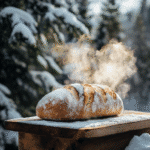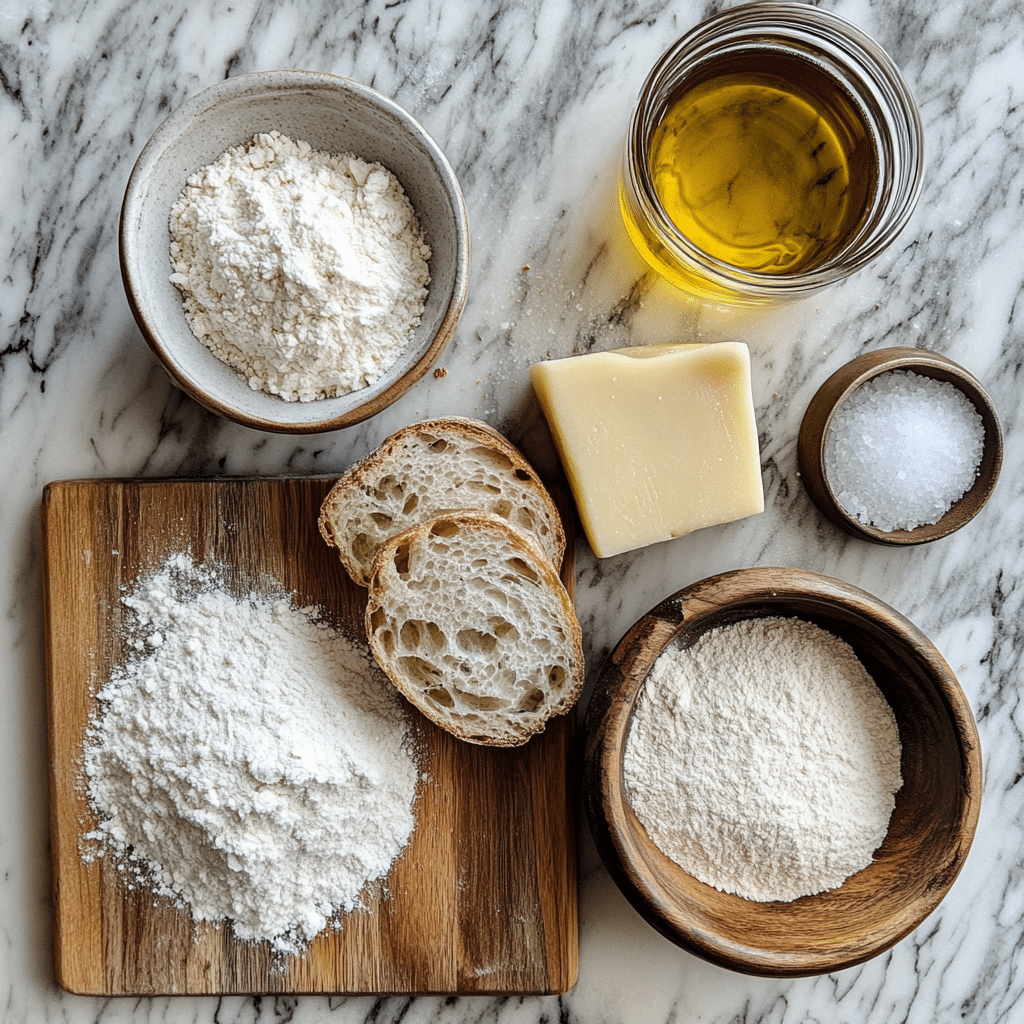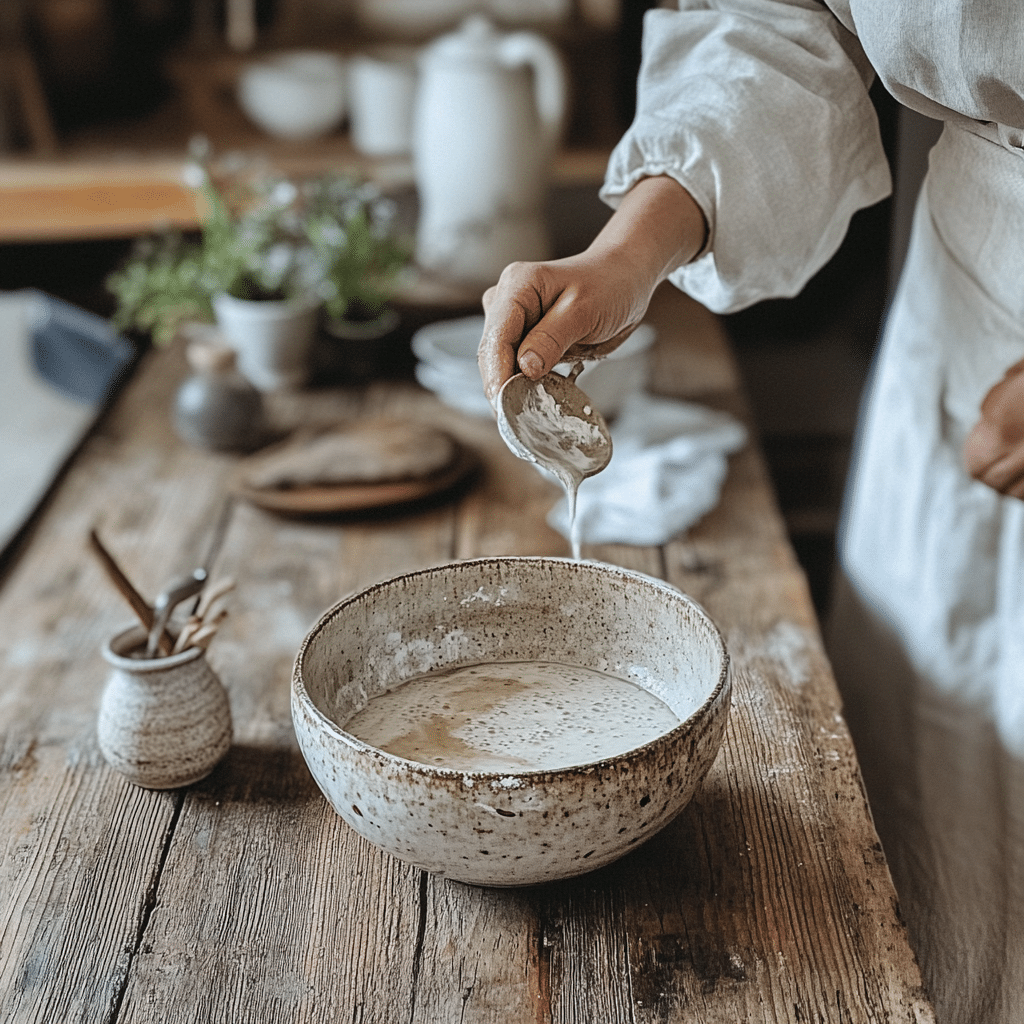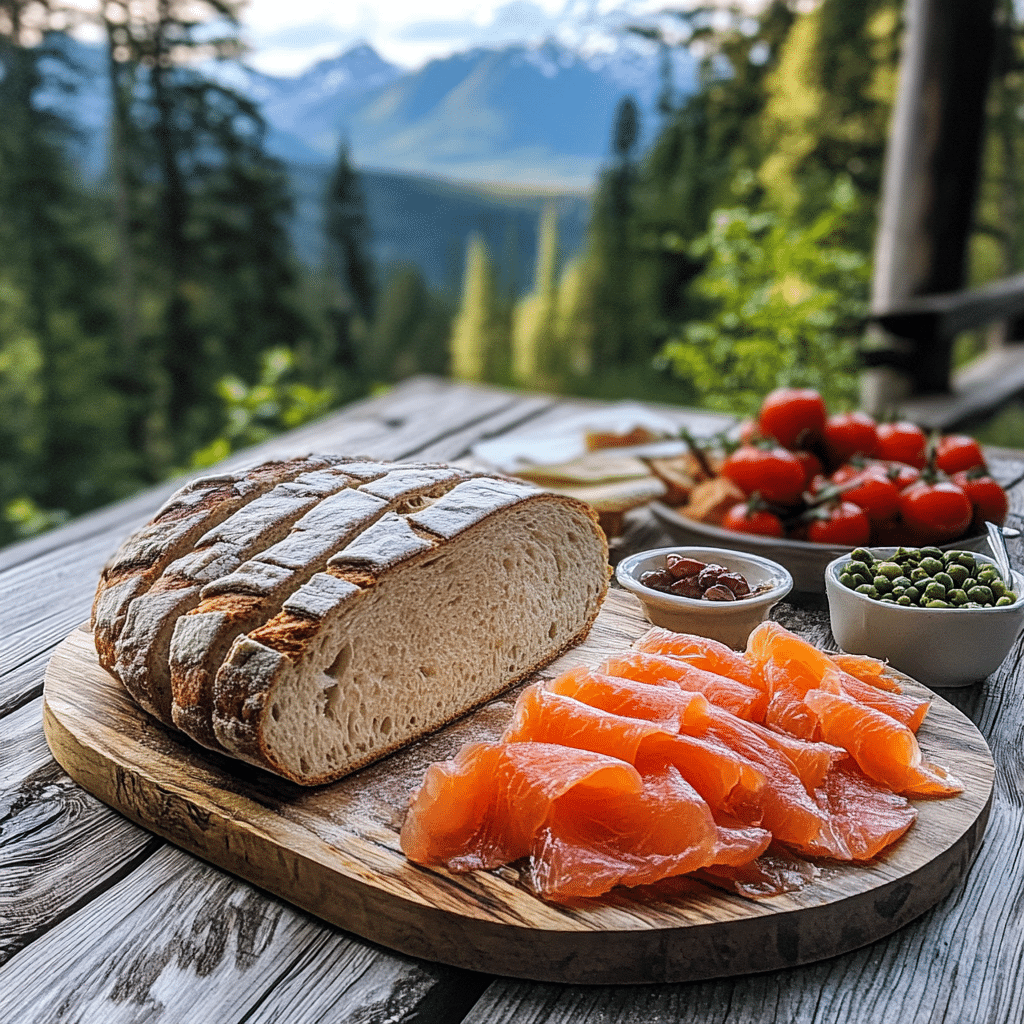The story of sourdough anchorage is not just about a loaf—it’s about survival, culture, and a deep respect for fermentation in the Last Frontier. This article walks you through why sourdough is such a big deal in Anchorage, Alaska, how it’s different from other types of sourdough, how you can make your own version at home, and what “sourdough” means to the people who live there. Whether you’re a curious baker or a history-loving foodie, you’ll find inspiration (and a recipe) waiting.
The Story & Intro
My Sourdough Anchorage Memory
Hi, I’m Marlene Quinn, and if you’ve ever tried baking sourdough in Anchorage during February, you know exactly how wild that ride can be. The first time I brought Clementine (my starter) to Alaska, she sulked for days. The air was crisp, sea-salty, and quiet. The altitude and dryness played tricks. But something about sourdough anchorage stuck with me.
It all started at a tiny workshop in Midtown Anchorage. A retired bush pilot named Larry showed up in full Carhartt gear, sourdough starter in a baby jar from 1972. He said, “You don’t just bake bread here. You earn it.” And he was right.
That loaf we baked together—dense, crusty, tangy—tasted like the wind off Turnagain Arm and the soul of a town built on grit. Since then, I’ve returned many times, each visit confirming that sourdough anchorage isn’t a recipe. It’s a relationship—with weather, yeast, and memory.
If you’ve never baked in Alaska, it’s like cooking in a giant walk-in fridge that smells like pine and snow. But it makes the bread better. Stronger. The kind of loaf that pairs with salmon chowder, fresh halibut, or a mug of black spruce tea.
Why Sourdough Feels Different in Alaska
There’s something undeniably rugged about sourdough in Anchorage. It’s not the fluffy, bakery-perfect loaf you’d find in a San Francisco cafe. Sourdough anchorage has weight, soul, and a chewy crust that talks back.
The difference lies in the fermentation process. Anchorage’s cooler climate slows everything down. Bakers here don’t rush. A typical loaf might ferment over 36 hours, developing flavors you just don’t get in warmer zones. And it’s not just science—it’s tradition. Alaska’s early gold miners and trappers relied on sourdough to survive long winters. They carried starters in pouches, sleeping with them to keep them warm.
Even today, many households in Anchorage name their starters like pets—just like I did with Clementine. And many use old family recipes, often scribbled on weathered index cards tucked into wooden boxes.
Sourdough anchorage is about more than just flour and water—it’s about place, patience, and pride.
Print
Sourdough Anchorage – 7 Secrets of Bold, Wild Alaskan Bread
- Total Time: 15 hours
- Yield: 1 large loaf 1x
- Diet: Vegetarian
Description
This classic sourdough anchorage recipe brings the bold tang and hearty texture of Alaskan fermentation into your kitchen.
Ingredients
100g active sourdough starter
375g filtered water
500g bread flour (or mix with 100g whole wheat or rye)
10g fine sea salt
Instructions
1. Mix starter and water in a bowl.
2. Add flour and mix until shaggy. Rest 30 min.
3. Add salt, mix well, cover and bulk ferment 8–10 hours.
4. Do 4 stretch-and-folds over 3 hours.
5. Shape and cold proof for 12–18 hours.
6. Bake at 475°F in Dutch oven for 20 min covered, 25 min uncovered.
Notes
Best results when fermented at cool room temperature (around 68°F).
Use rice flour in banneton to prevent sticking.
Let cool completely before slicing.
- Prep Time: 14 hours
- Cook Time: 45 minutes
- Category: Breads
- Method: Fermentation + Baking
- Cuisine: Alaskan-American
Nutrition
- Serving Size: 1 slice (of 12)
- Calories: 180
- Sugar: 0g
- Sodium: 320mg
- Fat: 0.5g
- Saturated Fat: 0g
- Unsaturated Fat: 0.5g
- Trans Fat: 0g
- Carbohydrates: 36g
- Fiber: 2g
- Protein: 6g
- Cholesterol: 0mg
Keywords: sourdough anchorage, cold fermented bread, Alaskan sourdough
Sourdough Anchorage Flavor & Fermentation Secrets
What Sets Alaskan Sourdough Apart
So what really makes sourdough anchorage different from the rest of the sourdough-loving world? It’s in the yeast—wild, local, and slow to act.
Unlike other regions where sourdough starters can be bubbly within hours, Alaska’s cooler, drier climate slows wild yeast activity. That means longer fermentation, which builds a deep, rich tang. The air in Anchorage holds a different microbial makeup. You’re not just baking with flour and water—you’re baking with local identity.
In many parts of the U.S., starters develop that mild yogurt-like acidity. But in sourdough anchorage, you’ll often taste sharp, bright notes followed by an earthy finish. That unique profile comes from the wild Lactobacillus cultures found only in Alaska’s environment.
Another big difference is texture. Bakers in Anchorage lean toward rustic loaves with thicker crusts and an open crumb. It’s practical—these breads hold up well to thick stews, smoked salmon spreads, and butter made from cream bought at the local farmers market.
Anchorage sourdough also tends to be frugal. It’s common to see bakers using sourdough discard to make everything from pancakes to crackers.
The Science of the Cold Rise
Anchorage is practically built for cold fermentation. In most homes, even without a fancy proofing box, the ambient winter temperature gives your dough the perfect environment to develop.
Let’s break it down. When fermentation slows in the cold, yeast has time to work gently through the flour. That longer rise allows enzymes to unlock sugars trapped in the starch, giving you more flavor without adding sweeteners.
And here’s the bonus: cold rising reduces the gluten strain. That means your dough becomes more extensible, which translates into a better oven spring and a crust that shatters like glass when you cut into it.
Many Anchorage bakers place their proofing baskets near lightly cracked windows in winter or store the dough in unheated pantries overnight. It’s an old-school technique that doesn’t require fancy tools—just patience and trust.
Sourdough anchorage isn’t just shaped by ingredients. It’s shaped by weather, rhythm, and a culture that honors doing things the slow way—on purpose.
Making Your Own Sourdough Anchorage-Style
Ingredients You Need to Capture Anchorage’s Flavor
You don’t need to live in Alaska to bake like you do. If you want your sourdough to channel that sourdough anchorage soul, it starts with your ingredients.
Flour: Choose unbleached bread flour with high protein (at least 12%). Many Alaskan bakers also blend in a bit of rye or whole wheat for depth. Rye performs especially well in colder fermentations.
Water: Filtered or spring water is best. Chlorine in tap water can inhibit the wild yeast. Anchorage bakers often use glacier-fed well water, but don’t worry—you can still make great loaves with bottled spring water.
Salt: Use fine sea salt. Coarse grains don’t dissolve evenly in slow-ferment loaves.
Starter: Here’s where things get real. Your starter is everything. Clementine, my own beloved starter, took on new flavors after a few weeks in Anchorage. If you’re building your own, leave it out for 7–10 days, feeding daily with equal parts flour and water. Keep it cool (ideally 65°F). That encourages the tangy, slow-growing wild yeast strains similar to those in sourdough anchorage.
Anchorage-style sourdough isn’t about fancy tools or boutique ingredients. It’s about choosing thoughtfully and trusting the process.

A Step-by-Step Sourdough Anchorage Loaf
Here’s a tried-and-true method for a classic sourdough anchorage-inspired loaf:
1. Mix (Night 1):
- 100g active starter
- 375g filtered water
- 500g bread flour
- 10g sea salt
Stir together the starter and water. Add the flour, mix until shaggy. Rest 30 minutes, then mix in the salt. Let rest in a covered bowl at 68°F overnight (8–10 hours).
2. Bulk Fermentation (Day 2, AM):
Perform 4 stretch-and-folds over 3 hours. Dough should become smoother and puff slightly.
3. Cold Proof:
Shape into a boule or batard. Place in a floured banneton or bowl. Cover and refrigerate for 12–18 hours.
4. Bake (Day 3):
Preheat Dutch oven to 475°F. Score loaf, then bake covered for 20 minutes and uncovered for another 20–25 minutes. Let cool at least 1 hour.
Sourdough anchorage baking takes a little more time and care, but what you get in return is unmatched flavor and character in every bite.

Culture, Slang & FAQs Around Sourdough Anchorage
Sourdough as a Word & Identity in Alaska
In Alaska, sourdough means more than bread—it’s a badge of honor. The term “sourdough” refers to someone who’s lived through at least one full Alaskan winter. If you’ve braved the cold, the dark, and the solitude, locals say you’ve “earned your sourdough stripes.”
The nickname dates back to the Klondike Gold Rush. Miners carried sourdough starters in pouches to make bread on the trail. Those who survived the brutal winter were dubbed “sourdoughs”—resilient, resourceful, and just a little bit wild.
In Anchorage, you’ll still hear the term tossed around. “You’re not a real sourdough until you’ve shoveled your roof and baked bread during a blackout,” one local told me at a bake-along night. And he wasn’t kidding.
Baking sourdough in Alaska means working with what you’ve got. It means sharing your starter with neighbors, even if it’s in a recycled salsa jar.
Sourdough anchorage isn’t just a baking technique. It’s a slice of local identity.

FAQs About Sourdough Anchorage
Did Trader Joe’s stop selling sourdough?
Yes, in some locations, Trader Joe’s has discontinued specific sourdough products, likely due to regional demand and supply chain adjustments. But if you’re craving that tang, a homemade sourdough anchorage loaf will beat any store-bought version in flavor and authenticity.
What is different about Alaska sourdough?
Alaska sourdough, especially in Anchorage, has a deeper tang due to its longer fermentation in cold temperatures. Wild yeast behaves differently in the Arctic air, producing denser loaves with a rich crust and bold interior. This sets it apart from milder, fast-risen loaves in warmer climates.
Is sourdough actually healthier than regular bread?
Generally, yes. Sourdough has a lower glycemic index, is easier to digest, and contains beneficial bacteria and acids that help nutrient absorption. The slow fermentation process also breaks down gluten, making it gentler for some sensitive eaters.
What is a sourdough Alaska slang?
“Sourdough” is Alaskan slang for a seasoned local who’s weathered at least one full winter. It’s a term of endearment and respect, rooted in the state’s frontier baking history. In other words, being called a sourdough in Alaska means you’ve earned your place.
Conclusion
Whether you’re baking through blizzards or from a sunny apartment kitchen, sourdough anchorage is more than a bread—it’s a story, a symbol, and a slice of Alaskan pride. From wild yeast to wild winters, every loaf tells a tale of patience, perseverance, and place.
So feed your starter, warm up your oven, and don’t be afraid to name your dough. Clementine and I will be cheering you on from Mendocino—with flour-dusted hands and full hearts.

